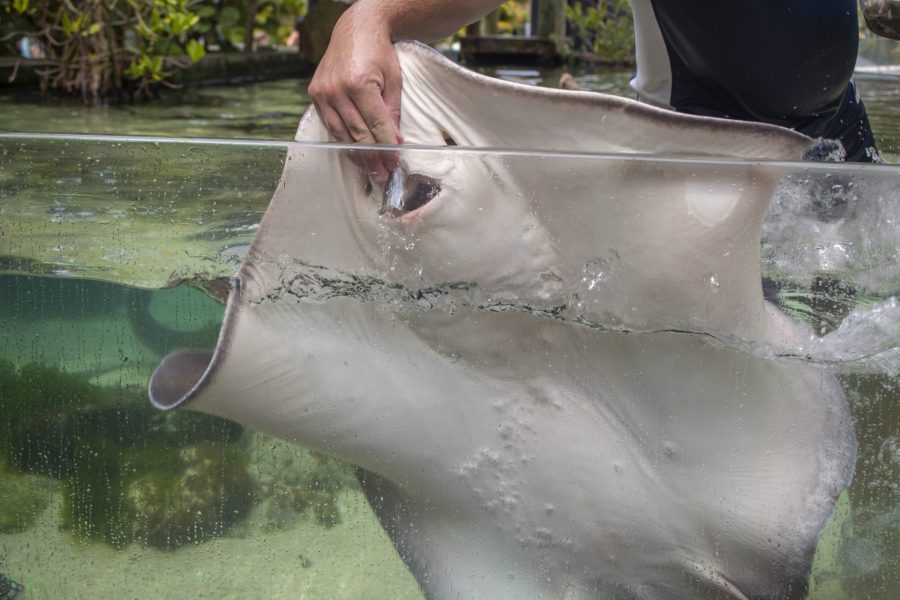Summary of Meet the Animals: Stingrays – Brevard Zoo:
The Brevard Zoo has started a “Meet the Animals” section of its blog to introduce visitors to some animals that may be difficult to see. One group of animals that may be missed is the stingrays, including six Southern stingrays and two Atlantic stingrays. Each stingray has their own personality and eating habits. The zoo has switched to individualized diets for the stingrays and uses puzzle feeders for enrichment. The stingrays coexist peacefully with other species in their aquarium. Visitors used to be able to interact with and feed the stingrays, but the zoo has made changes to improve their health and well-being. Stingrays are elasmobranchs, which are cartilaginous fish.
Meet the Animals: Stingrays at Brevard Zoo
If you’ve ever visited the Brevard Zoo in Florida, you may have encountered some of its 900 animal residents. While some animals are easy to spot, others may be more elusive due to their habitat setup, behavior, or sleep cycles. This is why the zoo has started a “Meet the Animals” section on its blog, to introduce visitors to some of the more hidden and exciting residents. One such animal group is the stingrays, found in the Indian River Lagoon-themed aquarium at the Paws On loop.
The Brevard Zoo has eight stingrays, six Southern stingrays and two Atlantic stingrays. The Southern stingrays have a symmetrical diamond shape, while the Atlantic stingrays have a tapered, pointy rostrum. The Herps & Aquatics animal care team at the zoo carefully cares for these rays.
Each stingray at the zoo has its unique personality. Here’s a breakdown of some of the individuals:
– Memphis: A 14-year-old dark brown Southern stingray, Memphis is one of the most active stingrays. He is often seen swimming fast and flapping on the windows. Memphis is also known for approaching the feeding area quickly and eagerly and is not afraid to steal leftovers from his fellow rays.
– Rhett: This 14-year-old Southern stingray is often described as the “sweetest” stingray. He is a peaceful presence and approaches calmly, patiently waiting for food. Keepers and veterinary staff belove Rhett’s caring nature towards other rays during exams.
– Dallas: One of the first stingrays born at Brevard Zoo, Dallas is more hesitant to approach new things or keepers. However, when it comes to mealtime, he goes all in, approaching fast and eagerly. Dallas has the shortest tail of all the rays.
– Jasper: Born at Brevard Zoo, Jasper is usually the first to wake up and swim around every morning. He can be a bit picky with food but excels at puzzle feeders. Jasper often swims away if the food is not perfectly lined up with his mouth.
– Theodore: Also born at Brevard Zoo, Theodore is a well-mannered stingray. He often sits on the sand by the feeding window, waiting for a sound cue to invite him up to eat. Theodore is not a picky eater and is smaller in size compared to the other rays.
– Wheeler: The last Southern stingray born at the zoo before the females moved to another aquarium, Wheeler is a creature of habit. He likes to sleep in the same spot every night and can be picky with food, except for shrimp, which he loves. Wheeler is more diminutive and had a hand displacing Memphis from his sleeping spot.
– Trixie: This 9-year-old Atlantic stingray has a unique personality. She can be ravenous one day and not interested in food the next. Trixie eats on the substrate instead of the window like the other rays. She also has a history of sitting on keepers’ feet to ask for food.
– Jackson: A very active dark brown Atlantic stingray, Jackson is often seen cruising around the aquarium. He usually pursues Trixie as he attempts to court her during the mating season. Jackson can be a challenging eater, as he presses his body flat against surfaces, making it difficult to feed him.
The stingrays share their aquarium with other species native to the Indian River Lagoon, including hermit crabs, Atlantic tarpons, black drums, black bar sheepshead seabreams, common snooks, grey snapper, hardhead sea catfish, and red drums. Despite this diverse mix of species, the rays coexist peacefully with their tank mates.
In the past, visitors to the Brevard Zoo were able to interact with and feed the stingrays. However, the animal care team decided to make changes to improve the health and well-being of the rays. This included implementing individualized diets for each ray, which allows for precise monitoring of their food consumption and accurate dosage of daily vitamin supplements. Keepers who can distinguish between the rays now handle their feeding, enabling closer observation of their health and body condition.
To provide enrichment, the stingrays at Brevard Zoo enjoy puzzle feeders. These feeders simulate their natural foraging behaviors, such as crunching shells and sucking the meat out of shellfish. The rays are also intrigued by unique items in their environment, such as felt strips resembling kelp and vertically placed hula hoops. Bubble streams and other environmental features further enhance their habitat.
The stingrays at the Brevard Zoo are fascinating animals and serve as ambassadors for their species. The zoo aims to raise awareness about protecting these incredible creatures and their habitats through education and conservation efforts.
So, next time you visit the Brevard Zoo, don’t forget to stop by the Indian River Lagoon-themed aquarium and say hello to the diverse and captivating group of stingrays that call it home!


